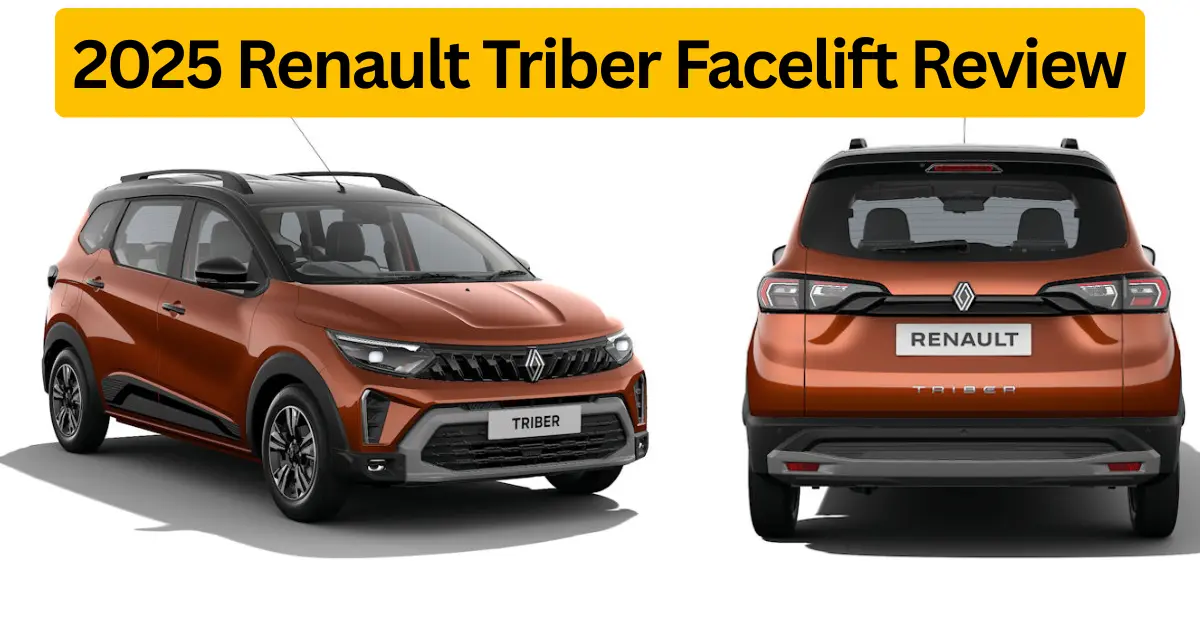Renault India has officially unveiled the 2025 Triber Facelift, introducing a refreshed design, modern features, and improved cabin experience. However, the much-anticipated turbo-petrol engine remains missing. Here’s a detailed breakdown of what the new Triber facelift offers.
Pricing and Variants
The new 2025 Renault Triber Facelift is priced from ₹6.3 lakh to ₹9.17 lakh (ex-showroom). Compared to its previous version, the facelift commands a price hike ranging from ₹1,000 to ₹41,000, depending on the variant selected.
Exterior Upgrades: New Look, New Emblem
Renault has given the Triber a more premium and muscular appearance:
- A redesigned front grille in gloss black
- LED projector headlamps with halogen turn indicators
- New LED fog lamps
- Front parking sensors
- Renault’s new diamond logo, marking its debut in the Indian lineup
- Chrome accents around the lights and grille
From the rear:
- LED tail lamps
- Updated Triber badge and Renault emblem
- Rear camera, rear parking sensors, wiper, washer, and defogger
- Integrated high-mount stop lamp
Side Profile and Wheels
The side design remains mostly unchanged, but new wheel designs add flair:
- Flex wheels with steel rims disguised as alloys
- Option to upgrade to real alloy wheels for ₹10,000 extra
- 185/65 R15 tyre profile with disc brakes in front and drum at the rear
- Roof rails, ORVMs with turn indicators, and blacked-out door handles
Interior: More Premium Cabin
The cabin now feels more upmarket, featuring:
- Dual-tone dashboard with wooden textured inserts
- New seat upholstery
- 8-inch infotainment system with wired Android Auto and Apple CarPlay
- Updated instrument cluster with features like TPMS, fuel economy history, trip meters, and service intervals
However, hard plastics are still used throughout the cabin, and the steering wheel is only partially leather-wrapped—where hands typically don’t rest.
Seating Comfort and Space
Triber continues to offer true 7-seater practicality:
- Second-row seats are adjustable and spacious, offering decent under-thigh support and headroom
- Third-row seats are usable even for adults, with ample legroom and roof-mounted AC vents
- Boot space is limited with all rows up, but folding or removing the third row offers decent cargo area
- Individual armrest for the driver (none for co-driver)
- Rear AC vents, magazine holders, ISOFIX mounts, and ample storage compartments
Safety Features
Renault has focused heavily on safety in the facelift, offering:
- Six airbags (top variant)
- ABS with EBD
- Electronic Stability Program (ESP)
- Hill Start Assist
- Traction Control
- TPMS (Tyre Pressure Monitoring System)
All of these are now standard features, adding a big plus to the car’s value.
Engine and Driving Experience
The most significant letdown is the absence of the 1.0L turbo-petrol engine. The facelift retains the same:
- 1.0L, 3-cylinder naturally aspirated petrol engine
- Power output: 72 PS and 96 Nm
- Transmission options: 5-speed manual and AMT (only in top variant)
Performance Observations:
- Engine lacks punch, especially with 6-7 occupants or uphill drives
- Needs frequent gear shifts and high revs to extract performance
- Light clutch, but gearbox feels slightly notchy
- NVH levels are average—engine and road noise creep into the cabin on rough patches
- Suspension setup is slightly stiff, better balanced with more passengers onboard
- Steering is light and city-friendly, but feedback is limited
- Brakes offer good bite and stability
Fuel Efficiency
Due to the need to rev the engine often, fuel economy takes a hit:
- City mileage: 11–12 km/l
- Highway mileage: 13–14 km/l
This is adequate but falls short of expectations, especially in the 7-seater segment.
Verdict: A Smart Family Mover with a Key Miss
The 2025 Renault Triber Facelift is a highly practical and affordable 7-seater, now better equipped in terms of safety and comfort. The third row is genuinely usable, and the exterior/interior styling updates make it feel more premium than before.
However, the absence of a turbo-petrol engine remains its biggest shortcoming. This limits performance, especially when fully loaded or driving uphill. If Renault had introduced the 1.0L turbo variant from the Kiger, the facelift would have been a much stronger package.
Also Read –
